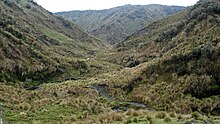Sangay National Park
|
Sangay National Park
|
||
|
The national park near Macas |
||
| location | Ecuador | |
| surface | 5118 km² | |
| WDPA ID | 188 | |
| Geographical location | 2 ° 2 ′ S , 78 ° 29 ′ W | |
|
|
||
| Setup date | 1979 | |

The Sangay National Park ( Spanish Parque Nacional Sangay ) is located on the eastern mountain range of the Andes in central Ecuador and is around 517,000 hectares in size. He was born on 26. July 1979 founded and became part 1983 for World Heritage of UNESCO .
history
In 1975 the area was placed under protection as a National Wildlife Reserve on an area of 2719 km². In 1979 the status of national park was raised. The area was expanded in 1992 by 2,458 km² and thus roughly doubled.
geography
In the park, which is at an altitude of 800 to 5319 meters, there is a subtropical climate with temperatures of up to 26 ° C. There are three volcanoes in the Sangay National Park : the eponymous, 5230 m high Sangay , the Tungurahua and the El Altar volcano .
With a height of 5319 meters, El Altar is also the highest point in the park. The lowest point is about 800 meters.
The Sangay National Park includes parts of the provinces of Cañar , Tungurahua , Chimborazo and Morona Santiago .
vegetation
More than 80% of the park area is covered by natural vegetation. There are three fundamentally different vegetation zones: (1) Alpine and subalpine páramo (wet grasslands), (2) cloud and mountain rainforests and (3) tropical lowland rainforests . Of particular importance are the Páramo areas.
Wildlife
The park, which serves to protect nature and culture, is an important refuge for rare animals such as B. Tapirs , spectacled bears and Andean condors . The park is one of the most important refuges for the rare mountain tapir. In addition to the mountain tapir, pumas , Andean jackals and mountain guinea pigs are typical inhabitants of the alpine and subalpine areas. Spectacled bears, giant otters, jaguars, ocelots, long-tailed cats, lowland tapirs , white-tailed deer ( Odocoileus virginianus clavium ), red mazamas and northern pudus live in the forests below . A total of around 300–400 species of birds live in this area, which has not yet been thoroughly investigated.
threat
Between 1992 and 2005 the park was on the Red List of World Heritage in Danger due to road construction plans . Poaching, illegal cattle grazing and other encroachments on the edges of the reserve are further threats.
swell
- ↑ a b c d United Nations Environment Program / World Conservation Monitoring Center: Sangay National Park, Ecuador. (PDF; 132 kB) ( Page no longer available , search in web archives ) Info: The link was automatically marked as defective. Please check the link according to the instructions and then remove this notice.
- ↑ Downer, CC: The mountain tapir, endangered 'flagship' species of the high Andes . Oryx. Vol. 30, no. 1, pp. 45-58. 1996. online abstract ( Memento of the original from November 27, 2011 in the Internet Archive ) Info: The archive link was inserted automatically and has not yet been checked. Please check the original and archive link according to the instructions and then remove this notice.




